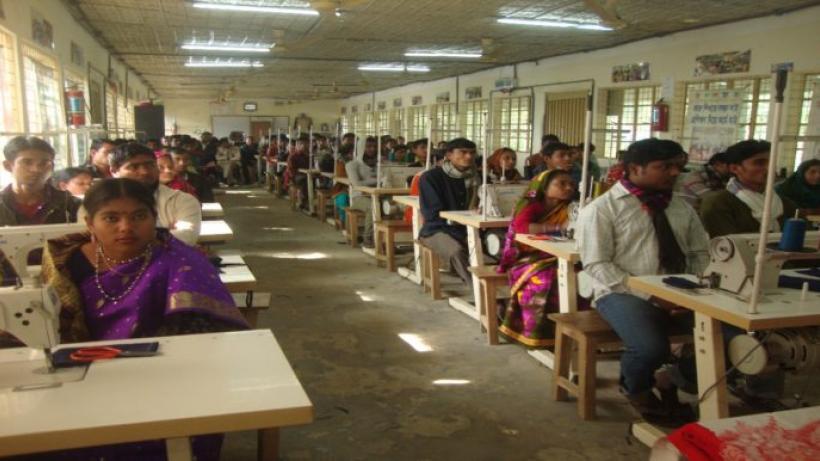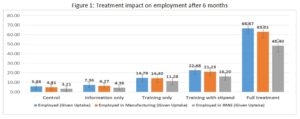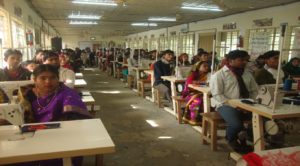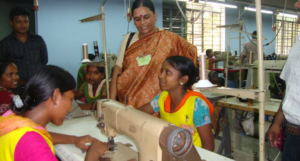
Barriers to labour migration in Bangladesh’s garment sector
A rigorous randomised controlled trial (RCT) impact study shows how a targeted training-programme, stipend and on-the-job training (OJT) intervention may have a significant effect on worker participation in Bangladesh’s ready-made garments (RMG) sector.
Interestingly, training is only effective in increasing participation in the sector when it is bundled with a stipend, and industry attachment increases further when OJT is added. The impact of these interventions likely reflects the spatial mismatch between the location of workers and RMG jobs. Data from a follow-up study affirms how these interventions have a statistically significant effect on employment.
Economic development and skills development
A skilled workforce is one of the fundamental requirements for an economy’s growth and development. Hence, skill development programmes are a top policy priority for developing countries like Bangladesh. With a large youth workforce and an increasing demand for skilled labour in manufacturing industries, Bangladesh has huge scope for utilising its youth workforce as a key instrument of growth and development.
Bangladesh’s ready-made garments sector
Bangladesh has been experiencing remarkable growth in the ready-made garment sector for the last three decades. The sector has become an integral part of its economy, contributing an estimated one percent of the GDP (Bangladesh Bureau of Statistics Yearbook, 2014) and 81.68 percent of export earnings (Export Promotion Bureau, Bangladesh, 2014).
In 1984 there were only 0.12 million people employed in the RMG sector. Employment has grown at an average annual rate of 17 percent, resulting in current employment reaching over 4 million workers (Bangladesh Garment Manufacturers and Exporters Association, 2014). A recent study by the Bangladesh Institute of Development Studies (BIDS) estimates that the sector will need an additional 1.5 million skilled workers by 2021.
A recent study by the Bangladesh Institute of Development Studies (BIDS) estimates that the sector will need an additional 1.5 million skilled workers by 2021.
RMG worker participation and migration costs
A notable feature of the RMG sector is that the factories are concentrated in the Dhaka and Chittagong areas, and the majority (85%) of garment workers are migrants from elsewhere in the country. However, their distribution by source region is unbalanced. In particular, northern Bangladesh has the lowest participation rate for workers in the garment industry, in spite of being one of the most poverty-stricken regions of Bangladesh.
As of 2010, poverty rates were about 11 percentage points higher in the north than in the rest of the country. A lack of relevant skills, the absence of a job-related network, inadequate information about the RMG industry, and migration costs relative to potential incomes, have contributed to the low participation of workers from northern Bangladesh.
A lack of relevant skills, the absence of a job-related network, inadequate information about the RMG industry, and migration costs relative to potential incomes, have contributed to the low participation of workers from northern Bangladesh.
The study
The study assesses the effectiveness of interventions designed to help individuals from northern Bangladesh secure jobs as sewing machine operators in the RMG sector. Working with a local non-governmental organisation (NGO), Gana Unnayan Kendra (GUK), the study randomly allocated eligible participants in the Gaibandha district of Rangpur, with one of four different job-related interventions, or to a control group.
The interventions:
- A day-long job-related information session for eligible candidates;
- A one-month long residential skill training, located in Gaibandha, on swing machine operations as well as basic technical know-how of the RMG industry;
- A one-month long residential skill training plus a moderate financial stipend (3500 BDT or about 45 USD) to support migration and forgone income;
- A one-month long residential skill training, financial stipend and a one month paid internship (or OJT) in a factory located in the Dhaka (full treatment).
Bundled interventions better address multiple constraints
Preliminary findings based on follow-up data collected six months after the training show that the treatments have a large effect on employment in the RMG sector (see Figure 1). Only 3.3% of the control group and 4.4% of the information-only group were employed in the RMG sector at the six-month follow-up.
Relative to the control group, those receiving training alone are about 8 percentage points more likely to be employed in the sector. The stipend increases the treatment effect by an additional 5 percentage points, and the stipend plus OJT increase the treatment effect by a further 32 percentage points.
Thus, we find that 48.4 percent of those receiving the full treatment were employed in the RMG sector, a rate substantially higher than any other treatment groups. A similar pattern of impact is also evident for employment elsewhere in the manufacturing sector. The effect of the stipend and stipend-plus-OJT treatments suggest that migration costs are an important constraint to employment in the sector.
48.4% of those receiving the full treatment were employed in the RMG sector

RMG factory work and mental health
Currently, with the support of the International Growth Centre (IGC), the study is continuing to track the participants to assess the long-term impact of the training programme. It aims to measure the long-term impact of employment on the participant’s households and the health effects of working in the RMG sector.
This work will complement an ongoing IGC-sponsored study examining mental health issues among RMG workers (Woodruff et al., 2016). No study has yet been conducted to examine the health effect – beyond mental health issues – on factory workers in the context of the Bangladesh RMG sector. This longer-term impact study builds on an examination of the effect of factory work on health by Blattman and Dercon (2015) in Ethiopia, also sponsored by the IGC.
Stipends and OJT relieve the cost and risks of migration
The study is one of the few that find a substantial impact of training on employment, albeit only when combined with a stipend and an OJT training programme. There are two aspects of the results that need to be highlighted here. First, migration has monetary cost and credit constraints could play a role in these costs being a barrier to RMG sector participation. Risk is also a key constraint to migration. In the full treatment intervention, the stipend reduces the credit constraints related to the monetary cost of migration; while the OJT reduces the risk. These findings demonstrate that stipends and OJT could help overcome these barriers to RMG sector participation, which provides an important lesson for policy makers.
In the full treatment intervention, the stipend reduces the credit constraints related to the monetary cost of migration; while the OJT reduces the risk.
References
Bangladesh Bureau of Statistics. 2014. Bangladesh Statistics Yearbook 2014. Dhaka: Bangladesh Bureau of Statistics
Bangladesh Garment Manufacturers and Exporters Association
Blattman, C and Dercon, S. 2015. An experimental study of pro-poor growth: factories and wage work versus self-employment. The International Growth Centre. Available at: https://www.theigc.org/project/an-experimental-study-of-pro-poor-growth-factories-and-wage-work-versus-self-employment/
Star Business Report. 2016. 4m skilled workers needed by 2021: BIDS. Available at: http://www.thedailystar.net/business/4m-skilled-workers-needed-2021-bids-1326670
Woodruff, C; Machiavello, R; Rabbani, A; Ashraf, A and Lopez-Pena, P. 2016. Managing Shocks: Worker’s Well-being and Firm Productivity in the Bangladeshi Garment Sector. The International Growth Centre. Available at: https://www.theigc.org/project/managing-shocks-workers-well-being-and-firm-productivity-in-the-bangladeshi-garment-sector/
Woodruff, C; Shonchoy, A and Fujii, T. 2016. Training program for RMG sector: Long-term impact. The International Growth Centre. Available at: https://www.theigc.org/project/training-program-for-rmg-sector-long-term-impact/
Figure 2: First day of training at Gana Unnayan Kendra (GUK)

Figure 3: Participant in an internship in a factory (On-the-job training)


